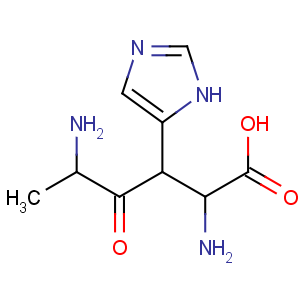Title: Dynorphin
CAS Registry Number: 74913-18-1
Literature References: Extremely potent, widely distributed neuropeptide that has 17 amino acid residues and contains leu5-enkephalin as its NH2-terminal sequence. Its name is derived from "dynamis", the Greek word for power, and endorphin, the name applied to the group of opioid peptides to which it belongs. Initially isolated from porcine pituitaries and termed
slow-reversing endorphin: L. I. Lowney
et al., Life Sci. 24, 2377 (1979). Purification, description of properties and amino acid sequence of the first 13 residues: A. Goldstein
et al., Proc. Natl. Acad. Sci. USA 76, 6666 (1979). Complete amino acid sequence of the heptadecapeptide from porcine pituitary:
eidem, ibid. 78, 7219 (1981). Isoln from porcine duodenum and identity with pituitary dynorphin: S. Tachibana
et al., Nature 295, 339 (1982). Synthesis of porcine dynorphin1-13: M. Wakimasu
et al., Chem. Pharm. Bull. 29, 2592 (1981). Soln conformation: R. Maroun, W. L. Mattice,
Biochem. Biophys. Res. Commun. 103, 442 (1981). Radioimmunoassay: V. E. Ghazarossian
et al., Life Sci. 27, 75 (1980). Comparison of distribution of dynorphin and enkephalin systems in brain: S. J. Watson
et al., Science 218, 1134 (1982). Behavioral effects of dynorphin1-13 in mice and rats: J. M. Walker
et al., Peptides 1, 341 (1980); H. Zwiers
et al., Life Sci. 28, 2545 (1981). Opiate activity and receptor selectivity: M. Wuester
et al., Neurosci. Lett. 20, 79 (1980); C. Chavkin, A. Goldstein
Nature 291, 591 (1981). In the guinea pig ileum bioassay it has been shown to be 700 times more potent than leu5-enkephalin and its agonist effects are 1/13th as sensitive to naloxone antagonism:
eidem, Proc. Natl. Acad. Sci. USA 78, 6543 (1981). Dynorphin1-13 has been proposed as the specific endogenous ligand of the
kappa opioid receptor (
cf. endorphins): C. Chavkin
et al., Science 215, 413 (1982). It has also been suggested that dynorphin1-8 or dynorphin1-9 may be transmitters or modulators at the kappa binding site and dynorphins 1-13 and 1-17 may act at a distance from the release site: A. D. Corbett
et al., Nature 299, 79 (1982). A possible regulatory role of dynorphin on morphine and b-endorphin-induced analgesia has been proposed: F. Tulunay
et al., J. Pharmacol. Exp. Ther. 219, 296 (1981); E. C. Petrie
et al., Peptides 3, 41 (1982). Several non-opiate effects have also been described: J. M. Walker
et al., Science 218, 1136 (1982); R. Przewlocki
et al., ibid. 219, 71 (1983).
Derivative Type: Dynorphin1-13
Synonyms: 1-13-Dynorphin (pig)
Molecular Formula: C75H126N24O15
Molecular Weight: 1603.95
Percent Composition: C 56.16%, H 7.92%, N 20.96%, O 14.96%
Properties: [a]D23 -62.9° (c = 0.5 in 1% acetic acid).
Optical Rotation: [a]D23 -62.9° (c = 0.5 in 1% acetic acid)

